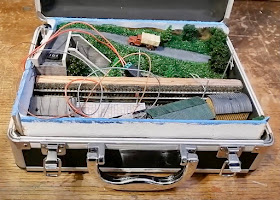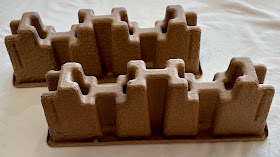At the end of the American Civil War the United States Navy had a total of four River Monitors, twenty-one Harbour Monitors, nineteen Coastal Monitors, and eleven Seagoing Monitors. The first two categories were disposed of in the years after the war ended.
The Coastal Monitors were the Passaic, Canonicus, and Milwaukee-classes. The ships of the latter class - which were riverine monitors capable of operating in coastal areas - were sold off by 1875, but the first two classes were kept in reserve and recommissioned during the Spanish-American War. With the exception of the USS Camanche - which was based in California - they were used to protect ports on the eastern coast of the United States from possible attacks by the Spanish Navy.
USS Camanche during the Spanish-American War.
The Passiac-class monitors (USS Passaic, USS Montauk, USS Nahant (renamed USS Atlas in June 1869 and reverted to her original name in August 1869), USS Sangamon (renamed USS Jason in June 1869), USS Patapsco (sunk by a mine in January 1865), USS Weehawken (sank during a gale in December 1863), USS Catskill (renamed USS Goliath in June 1869 and reverted to her original name in August 1869), USS Nantucket (renamed USS Medusa in June 1869 and reverted to her original name in August 1869), USS Lehigh, and USS Camanche) were improved versions of the USS Monitor. They were initially armed with one 15" and one 11" Dahlgren smooth-bore cannon or 8" Parrot gun in their single turret, but the 11" and 8" guns were later replaced by a second 15" one.
The Canonicus-class (USS Canonicus, USS Ajax (originally named USS Manyunk), USS Catawba (sold to Peru after completion and renamed Atahualpa), USS Mahopac (renamed USS Castor in June 1869 and reverted to her original name in August 1869), USS Manhattan (renamed USS Neptune in June 1869 and reverted to her original name in August 1869), USS Oneota (sold to Peru after completion and renamed Manco Capac), USS Saugus (renamed USS Centaur in June 1869 and reverted to her original name in August 1869), USS Tecumseh (sunk during the Battle of Mobile on 5th August 1864), USS Wyandotte (renamed USS Vesuvius in June 1869 and reverted to her original name in August 1869)) were improved versions of the Passiac-class monitors.
USS Lehigh.
The characteristics of the Passiac-class are:
- Displacement: 1,335 tons
- Dimensions:
- Length: 200ft (61m)
- Beam: 46ft (14m)
- Draught: 10ft 6in (3.2m)
- Propulsion: 2 x Martin boilers providing steam to a single-shaft Ericsson vibrating-lever steam engine
- Speed: 7 knots
- Complement: 75
- Armament (when built): 1 x 15-inch (380mm) muzzle-loading smooth-bore Dahlgren gun and 1 x 11-inch (280mm) muzzle-loading smooth-bore Dahlgren gun except for USS Lehigh and USS Patapsco which had 1 x 15-inch (380mm) muzzle-loading smooth-bore Dahlgren gun and 1 × 8-inch (200mm) muzzle-loading Parrott rifled gun and USS Camanche which had 2 x 15-inch (380mm) muzzle-loading smooth-bore Dahlgren guns
- Armour:
- Side: 3 to 5-inch (76 to 127mm)
- Turret: 11-inch (280mm)
- Deck: 1-inch (25mm)
USS Canonicus.
The characteristics of the Canonicus-class are:
- Displacement: 2,100 tons
- Dimensions:
- Length: 223 to 235ft (68 to 72m)
- Beam: 43 to 43ft 8in (13 to 13.31m)
- Draught: 13ft 6in (4.11m)
- Propulsion: 4 x boilers providing steam to a single-shaft vibrating-lever steam engine
- Speed: 8 knots
- Complement: 85
- Armament: 2 x 15-inch (380mm) muzzle-loading smooth-bore Dahlgren guns
- Armour:
- Side: 5-inch (127mm)
- Turret: 10-inch (254mm)
- Deck: 1.5-inch (38mm)
The eleven Seagoing Monitors were the USS Dictator, the USS Onondaga, the USS Puritan, the four Miantonomoh-class, and the four Kalamazoo-class.
The USS Dictator remained in service until 1877, and she was scrapped in 1883.
The USS Onondaga was sold back to her builder in 1867, who sold her to France. She remained in service (mostly in reserve) until she was sold in 1904 and scrapped in 1905.
The USS Puritan was never completed and was left on her building stock. By 1874 her hull had deteriorate and she underwent a ‘great repair’. In actuality, she was scrapped in 1874 and the money voted by Congress for her repair was used to build a new monitor with the same name.
The Miantomomoh-class (USS Miantomomoh, USS Agamenticus (renamed USS Terror in June 1869), USS Monadnock, and USS Tonawanda (renamed USS Amphitrite in June 1869)) were supposed to undergo ‘great repair’, but they were scrapped in 1874 and 1875 and the money used to build new monitors.
The Kalamazoo-class (USS Kalamazoo (renamed USS Colossus in June 1859), USS Passaconaway (renamed USS Thunderer in June 1859 and USS Massachusetts in August 1859), USS Quinsigamond (renamed USS Hercules in June 1859 and USS Oregon in August 1859), and USS Shackamaxon (renamed USS Hecla in June 1859 and USS Nebraska in August 1859)) were incomplete when the Civil War ended and were left on their building stocks. They were renamed in June 1869 and again in August 1869, but they remained there until they were scrapped in 1874 (USS Shackamaxon/Hecla/Nebraska) and 1884 (the remaining three ships of the class).
USS Dictator.
The characteristics of the USS Dictator are:
- Displacement: 4,438 tons
- Dimensions:
- Length: 312ft (95.1m)
- Beam: 50ft (15.2m)
- Draught: 20ft 6in (6.2m)
- Propulsion: 2 x vibrating-lever steam engines, each powering a propeller
- Speed: 10 knots
- Complement: 174
- Armament: 2 × 15-inch (380mm) muzzle-loading smooth-bore Dahlgren guns
- Armour:
- Side: 6-inch (152mm)
- Turret: 15-inch (381mm)
- Deck: 1.5-inch (38mm)
- Pilothouse: 12-inch (305mm)
The ex-USS Onondaga in French service.
The characteristics of the USS Onondaga are:
- Displacement: 2,592 tons
- Dimensions:
- Length: 226ft (68.9m)
- Beam: 50ft 5in (15.7m)
- Draught: 12ft (3.9m)
- Propulsion: 4 x water-tube boilers providing steam to 2 x back-acting steam engines, each powering a propeller
- Speed: 7 knots
- Complement: 130
- Armament: 2 x 15-inch (380mm) muzzle-loading smooth-bore Dahlgren guns and 2 x 150-pounder muzzle-loading Parrot rifled guns
- Armour:
- Side: 5.5-inch (140mm)
- Turret: 11-inch (279mm)
- Deck: 2-inch (51mm)
An artist's impression of how the USS Puritan would have looked had she been completed..
The characteristics of the USS Puritan (as designed) are:
- Displacement: 4,912 tons
- Dimensions:
- Length: 340ft (103.6m)
- Beam: 50ft (15.2m)
- Draught: 20ft (6.1m)
- Propulsion: 6 x Martin water-tube boilers providing steam to a two-cylinder vibrating-lever steam engine powering two propellers
- Speed: 15 knots
- Armament: 2 x 20-inch (508mm) muzzle-loading smooth-bore Dahlgren guns
- Armour:
- Side: 6-inch (152mm)
- Turret: 15-inch (381mm)
- Pilothouse: 12-inch (306mm)
A Miantomomoh-class monitor during the American Civil War.
The characteristics of the Miantonomoh-class are:
- Displacement: 3,400 tons
- Dimensions:
- Length: 258ft 6in (78.8m)
- Beam: 52ft 9in (16.1m)
- Draught: 12ft 8in (3.9m)
- Propulsion: Steam engines powering two propellers
- Speed: 10 knots
- Complement: 150 to 167
- Armament: 2 x 15-inch (380mm) muzzle-loading smooth-bore Dahlgren guns
- Armour:
- Side: 4.5-inch (114mm)
- Turret: 11-inch (279mm)
- Deck: 1.5-inch (38mm)
- Pilothouse: 8-inch (203mm)
An artist's impression of how the Kalamazoo-class monitors would have looked had they been completed.
The characteristics of the Kalamazoo-class (as designed) are:
- Displacement: 5,600 tons
- Dimensions:
- Length: 345ft 5in (105.3m)
- Beam: 56ft 8in (17.3m)
- Draught: 17ft 6in (5.3m)
- Propulsion: 8 x tubular boilers providing steam to 2 x two-cylinder horizontal direct-acting steam engines, each powering a propeller
- Speed: 10 knots
- Complement: 150 to 167
- Armament: 2 x 2 x 15-inch (380mm) muzzle-loading smooth-bore Dahlgren guns
- Armour:
- Side: 6-inch (152mm)
- Turret: 10 to 15-inch (254 to 381mm)
- Deck: 3-inch (76mm)





















































